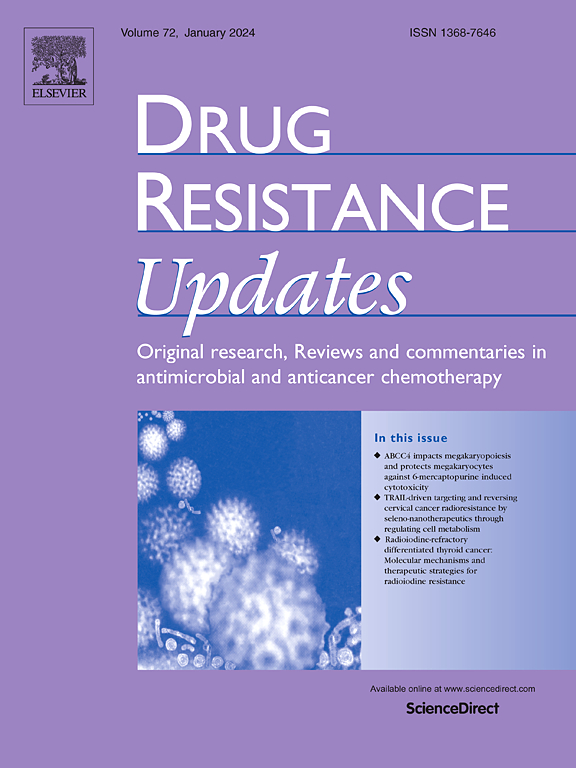聚合胶束紫杉醇、顺铂和替利单抗作为晚期不可切除食管鳞状细胞癌的一线治疗:一项不良反应患者耐药性分析的II期研究
IF 21.7
1区 医学
Q1 PHARMACOLOGY & PHARMACY
引用次数: 0
摘要
目的:评估聚合胶束紫杉醇(Pm-Pac)、顺铂和替利单抗作为晚期/转移性食管鳞状细胞癌(ESCC)一线治疗的有效性和安全性,解决传统紫杉醇方案与类固醇诱导免疫抑制相关的局限性。方法:这项II期临床试验招募了27例treatment-naïve期ESCC患者。该方案包括Pm-Pac(230 mg/m²),顺铂(70 mg/m²)和替利单抗(200 mg),在21天周期的第1天给药。在两个诱导周期后,非进展患者接受两个额外的周期,随后进行12个月的tislelizumab维持。主要终点:客观缓解率(ORR);次要终点:无进展生存期(PFS)、总生存期(OS)、疾病控制率(DCR)和安全性。探索性分析包括血细胞计数、肿瘤标志物、淋巴细胞亚群、生存分析、Kruskal-Wallis试验、聚类和LASSO回归。结果:该方案的ORR为62.96 %(95 % CI: 0.45-0.81),完全缓解(CR)为7.4% %,部分缓解(PR)为55.6% %。中位PFS为10.2个月,1年OS概率为81.48 %。治疗耐受良好,无≥ 3级治疗相关不良事件或死亡。探索性预测分析表明,结果与高钾血症、CD4 +CD25 + T细胞、肺转移和远处淋巴结转移有潜在的相关性。结论:pm - pac为基础的化学免疫疗法在晚期ESCC中显示出令人鼓舞的疗效和良好的安全性,支持其作为一线无类固醇选择的潜力。这些发现突出了纳米技术在优化化学免疫治疗中的作用。本文章由计算机程序翻译,如有差异,请以英文原文为准。
Polymeric micellar paclitaxel, cisplatin, and tislelizumab as first-line therapy for advanced unresectable esophageal squamous cell carcinoma: A phase II study with resistance profiling in poor responders
Objective
To evaluate the efficacy and safety of polymeric micellar paclitaxel (Pm-Pac), cisplatin, and tislelizumab as first-line therapy for advanced/metastatic esophageal squamous cell carcinoma (ESCC), addressing limitations of conventional paclitaxel regimens related to steroid-induced immunosuppression.
Methods
This phase II clinical trial enrolled 27 treatment-naïve patients with stage IV ESCC. The regimen consisted of Pm-Pac (230 mg/m²), cisplatin (70 mg/m²), and tislelizumab (200 mg) administered on day 1 of 21-day cycles. After two induction cycles, non-progressive patients received two additional cycles, followed by 12-month tislelizumab maintenance. Primary endpoint: objective response rate (ORR); secondary endpoints: progression-free survival (PFS), overall survival (OS), disease control rate (DCR), and safety. Exploratory analyses included blood counts, tumor markers, lymphocyte subsets, survival analysis, Kruskal-Wallis tests, clustering, and LASSO regression.
Results
The regimen achieved an ORR of 62.96 % (95 % CI: 0.45–0.81) with complete response (CR) in 7.4 % and partial response (PR) in 55.6 % of patients. Median PFS was 10.2 months, with 1-year OS probability of 81.48 %. Treatment was well-tolerated without grade ≥ 3 treatment-related adverse events or deaths. Exploratory predictive analyses suggested potential correlations between outcomes and hyperkalemia, CD4 +CD25 + T cells, lung metastases, and distant lymph node metastases.
Conclusions
The Pm-Pac-based chemoimmunotherapy suggests encouraging efficacy and favorable safety in advanced ESCC, supporting its potential as a first-line steroid-free option. These findings highlight the role of nanotechnology in optimizing chemoimmunotherapy.
求助全文
通过发布文献求助,成功后即可免费获取论文全文。
去求助
来源期刊

Drug Resistance Updates
医学-药学
CiteScore
26.20
自引率
11.90%
发文量
32
审稿时长
29 days
期刊介绍:
Drug Resistance Updates serves as a platform for publishing original research, commentary, and expert reviews on significant advancements in drug resistance related to infectious diseases and cancer. It encompasses diverse disciplines such as molecular biology, biochemistry, cell biology, pharmacology, microbiology, preclinical therapeutics, oncology, and clinical medicine. The journal addresses both basic research and clinical aspects of drug resistance, providing insights into novel drugs and strategies to overcome resistance. Original research articles are welcomed, and review articles are authored by leaders in the field by invitation.
Articles are written by leaders in the field, in response to an invitation from the Editors, and are peer-reviewed prior to publication. Articles are clear, readable, and up-to-date, suitable for a multidisciplinary readership and include schematic diagrams and other illustrations conveying the major points of the article. The goal is to highlight recent areas of growth and put them in perspective.
*Expert reviews in clinical and basic drug resistance research in oncology and infectious disease
*Describes emerging technologies and therapies, particularly those that overcome drug resistance
*Emphasises common themes in microbial and cancer research
 求助内容:
求助内容: 应助结果提醒方式:
应助结果提醒方式:


